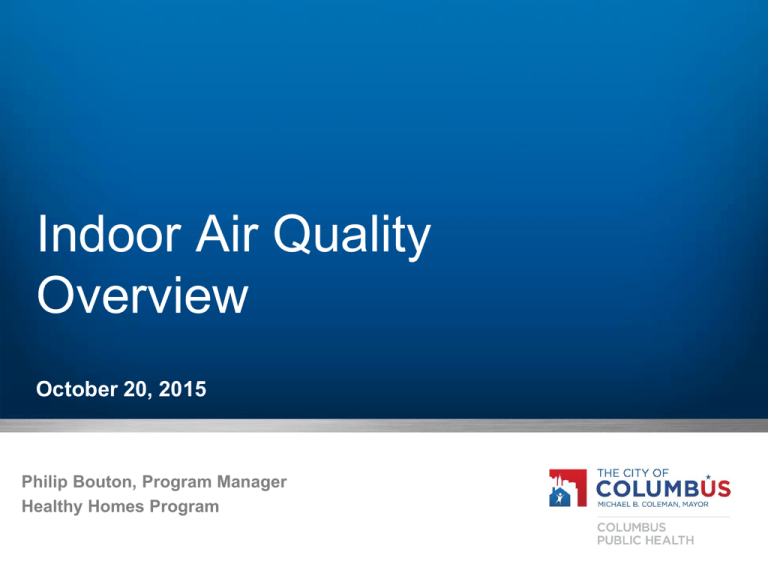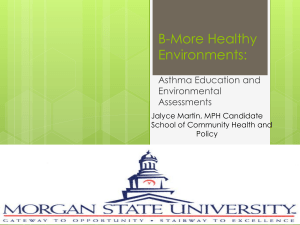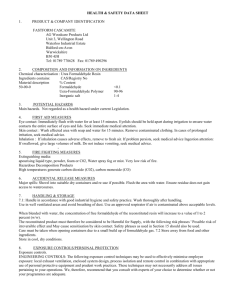Indoor Environmental Quality Overview
advertisement

Indoor Air Quality Overview October 20, 2015 Philip Bouton, Program Manager Healthy Homes Program Objectives • Understand some current trends and research for practitioners dealing with the indoor environment. • Identify actions to reduce or eliminate health risks in the home environment. • Know where to go for additional information to address indoor environmental hazards. • • Healthy Housing Watershed Events 1922 - League of Nations proposes worldwide Office of Healthy Homes and Lead Hazard lead paint ban Control is created 1978 – US bans sale of lead-based paint for • residential use • 1985 – US bans sale of leaded gasoline in cars • 1992 – Residential Lead Hazard Reduction Act created and provides training • • 1993 - Cleveland cluster of infant cases of 2003 - CDC begins addressing Healthy Homes issues (in addition to lead) and updates the 1976 Healthy Homes Inspection and Reference passed (Title X) • 2001 - National Center for Healthy Homes Manuals Pulmonary Hemosidorosis • 2004 – IOM Dampness and Mold Report 1996 – Residential Lead-based disclosure • 2007 - IOM Asthma Report 3 becomes law • 2009 - The Community Guide Best Practices for Asthma Interventions • 1997 - HUD develops HHI • 2000 - Clearing the Air IOM NHLBI Asthma • 2010 - EPA RRP Rules goes into effect Report • 2012 - CDC lowered the “reference level” for childhood lead poisoning” to 5 µg/dL According to the U.S. Surgeon General’s Call to Action to Promote Healthy Homes (2009): “Many of the disparities in health status among subpopulations may be linked to poor access to safe and healthy homes, which is most prevalent among lower income populations, populations with disabilities, and minority populations” Healthy and Safe Home Community Environments • Create, sustain, and recognize housing that promotes health and wellness through prevention • Health and wellness are also heavily influenced by the places in which people live • Environment Plays a Major Role in Children’s Health—their mental, educational, physical, and social well-being Why Do We Care About Healthy Homes? • Children suffer disproportionately from Environmental Health and Safety Hazards • Most of our non-occupational exposures occur in the home • Neurological, immunological, digestive, and other systems still developing • Eat, drink, and breathe more in proportion to their body weight than adults do • Size & weight diminish their protection from std. safety features • Behavioral patterns make them more susceptible to accidents and exposures • Exposures in childhood can cause chronic disease and premature death later in adulthood • Who else is at increased risk? Why do we care: Changing Times • There has been sustained anxiety and serious concern about mold, toxins and other housing related health effects nationwide, and in the developed world (Chinese Product Syndrome). • There has been a significant change in the composition of materials, products and how air tight our home are. • Rising concerns for energy conservation and environmental impact have lead to various guidelines and best practices for building, renovating, and maintaining a home—some without serious consideration for IEQ. Specific Types of Contaminants Associated with Housing Conditions • Microbiological – Fungi – Bacteria – Viruses • Environmental Allergens • Pests • VOCs • Pesticides • Radon • Tobacco Smoke • Combustion ByProducts • Ozone • Particulates • Lead • Sewer Gas Why do we care? Known/Suspected Health Effects Associated with Housing Conditions • • • • • • • • • • Respiratory Conditions Asthma Injuries and Burns Reactions to extreme cold and heat Irritations, allergies and rashes Poisonings, asphyxiation Neurotoxic Exposures Cancer Poor quality of life Death Causes of Poor IAQ • • • • • • • Design Construction Building Materials Appliances/HVAC/OA Maintenance Furnishing Behavior • Green & Healthy is Possible • Negated by behavior and Chinese product syndrome Principles of Healthy & Sustainable Housing • • • • Dry Ventilated Clean & Uncluttered Free of Contaminants – Pest & Pesticide – Combustion By-products – Lead Hazards – Other Contaminants • Free of Injury Hazards • Well Maintained • Affordable • Universally Accessible/Aging in Place • Secure from Intrusion • Resilient • In a Health Promoting Community • Green (reduced environmental impact) Start with the People • Don’t assume that your clients understand why or how they should have a clean and healthy home. • Its important to provide education on how health and housing are related. • As a public health professional, you may be the only professional your clients trust to receive information on how they can help improve their own health, and who they should speak to for more information and resources. Host Factors: Personal • • • • • • • Age Gender Race/ethnicity Genetics Immunity Occupation Socioeconomic Status Host Factors: Behavioral and Lifestyles • • • • • • • Activity/exercise Smoking Diet Household maintenance Risk-taking (unhealthy homes) Violence in home and community Sanitation and hygiene Host Factors: Susceptibility • • • • • • Children Elderly Pregnant and Nursing Women Medically Underserved People with Existing Health Conditions Poorly Nourished People Indoor pollutants can cause different reactions in people SENSITIVE GROUPS include those with: • • • • • • allergies asthma chemical sensitivities respiratory disease suppressed immune system Immature respiratory system • Surprise! Surprise! Perhaps You! Home Safety Keep a working smoke detector on every level Keep a CO alarm near the sleeping area first and basement second (~10’ from combustion appliances). Reduce fall & trip hazards Keep poisons locked away and out of sight & reach Keep the fridge below 420F Defrost foods in the fridge Refrigerate prepared foods after two hours Keep hot water less than 1210F Test your home for radon Remove Mercury Sources!!!!!!!!!!! Ounce of prevention = living and no permanent injuries. Ounce of Prevention = Pound of Cure. Cooking/Combustion Combustion by-products: • Ultrafine particulates, sulfur and nitrogen dioxides, VOCs including acrolein & formaldehyde, and other by-products cause irritation and can exceed the Clean Air Act—indoors! • Sources: gas stoves, electric stoves, unvented gas/fuel appliances, and wood burning appliances. Management: • Vent stove to outside (open window if no vent) • Cook on back burners closest to exhaust vent • Do not allow unvented combustion appliances • Don’t allow indoor/outdoor wood burning fireplaces Exhaust Stove Pollution -a Serious Issue! • Recirculating hoods just grease foreheads! • Exhaust hoods/microwaves vary greatly in efficiency and use. • Choose: HVI certified, ≥ 100-250 cfm, with good front burner coverage, ≤installed according to specifications, • Look for high air pressure rating (62.5 Pa) or use low pressure duct work. • Look for new standards/ratings in next year+ Volatile Organic Compounds: Smelly things that may harm you • Strong odors (perfume, smelly markers, cleaning chemicals (bleach, quaternary ammonium), paints, glues, nail polish, solvents, etc. • Most anything in an aerosol • Almost no one is 'normal' as to how we react to volatile organic compounds. • Those who have been previously sensitized can react to low levels (10's, hundreds or thousands of times lower than 'normal' people). Scented Products Emit a Harmful Bouquet of VOCs Tested 25 – air fresheners, – laundry detergents, – Fabric softeners, dryer sheets, – disinfectants, – dish detergents, – all purpose cleaners, – soaps, hand sanitizers, – lotions, deodorants, – and shampoos. Many of the products tested are top sellers in their category. Potera C Scented Products Emit a Bouquet of VOCs. Environ Health Perspect 2011. 119:a16-a16 . Avoiding VOCs • Apply outdoors • Ventilate: open windows and run exhaust fans to air out chemical odors – our sense of smell becomes desensitized • Safer products: – Low/no VOC products – water-based products – non-aerosol pump and liquid • Make your own natural cleaner using vinegar, water and dish soap or choose “unscented” or “ecofriendly” products from the store Formaldehyde et al • Study by Francis Offermann, Ventilation and Indoor Air in New CA Homes (NCHH Conf Call 10-20-2008) www.healthyhomestraining.org – Formaldehyde composite products will off-gas for years. – Can cause irritation below the odor threshold. – Many homeowners never open home for ventilation; 6% Spring and 29% Winter; formaldehyde and acetaldehyde elevated. – 67% of homes had air exchange rates below CBC requirement of 0.35 ach. – Of homes where carcinogens detected, significant levels found for formaldehyde (most common), acetaldehyde, benzene, 1,4dicholorobenzene, naphthalene, tetracholoroethene, tricholoromethane (chloroform). Formaldehyde et al • HRV mechanical outdoor air system performed well in increasing the home outdoor air exchange rates and reducing formaldehyde concentrations. • The DOA systems did not perform well as a result of a combination of the low outdoor air flow rates and low fan operation times. • Recommended installation of mechanical outdoor air ventilation systems in new single family residences to provide dependable and continuous supply of outdoor air to residences. • California Air Resource Board adopted an airborne toxics control measure in 2007 to reduce formaldehyde emissions in composite wood products. • US EPA review of formaldehyde was a failure Avoid VOCs and Formaldehyde • When purchasing pressed wood products (particleboard, MDF, or hardwood plywood), look for products that carry a CARB 93120.2 or ANSI label -American National Standards Institute (ANSI). The following standards indicate lower formaldehyde emission levels: (Particleboard should conform to ANSI A208.1-1993. For particleboard flooring, look for ANSI grades "PBU", "D2", or "D3". MDF should comply with ANSI A208.2-1994; and hardwood plywood with ANSI/HPVA HP-1-1994). • Use Low/No VOC products • Increase ventilation in the home by opening doors and windows and installing exhaust fan(s). • Install continuous exhaust or supply fan for the entire unit—timed exhaust allows unhealthy build-up of contaminants. CPSC - AN UPDATE ON FORMALDEHYDE http://www.cpsc.gov/PageFiles/121919/AN%20UPDATE%20ON%20FORMALDEHYDE%20final%200113.pd CARB - http://www.arb.ca.gov/toxics/compwood/compwood.htmf Indoor Air Quality Control Devices Room Air Cleaners: • Some scientific support for use of fan driven room HEPA filter correctly sized for room if cleaning the room regularly is not effective or near busy roadway – Other factors: noise, cost for maintenance/replacement parts • Electronic air purifiers and ion generators may produce ozone – No sound scientific support for ozone generators showing a health benefit—health threat to asthmatics and others—follow CA standard Duct cleaning is not a normal part of routine ventilation maintenance Duct cleaning for disaster events, and older homes 1x Routine ventilation cleaning and maintenance should include: – cleaning drain pans and cooling coils; – 1 to 3 month filter changes with MERV 8 filters disposable filters with cursory visual inspection; – cleaning and inspections 1/year for gas furnaces/ 2-3 years for electric. More information at www.epa.gov/iaq/ or www.nchh.org EHP: Polyurethane foam & polybrominated diphenyl ethers (PBDEs)PBDEs Rental environmental disclosure Montana Code § 70-16-703 MT Requires sellers, landlords or their agents to inform buyers or renters of the known presence of mold in a building and to provide buyers or renters with the results of any mold tests that have been conducted. Authorizes sellers, landlords, agents, and property managers to provide buyers or tenants with a mold disclosure statement specified in the statute. Provides for relief from liability in certain cases for sellers and landlords who comply with these provisions. Healthy Home Rating System (HHRS) • HHRS uses a risk-assessment methodology and is a system (not a standard) developed to enable risks from hazards to health and safety in dwellings to be removed or minimized for all current and future occupants. • The HHRS provides an analysis of just how hazardous a dwelling is and provides evidence and statistical methods to assist assessors in making their judgments. • Each of the 29 hazards are assessed separately. Healthy Home Rating System 29 Hazards The simplified formula is: Risk (likelihood) x Outcome = Numerical Score IAQ Resources • Columbus Public Health Smoke-Free Housing Tool Kit www.columbus.gov/publichealth • CDC Healthy Housing Reference Manual (technical, but not too!) www.cdc.gov/nceh/publications/books/housing/housing.htm • Environmental Health Perspectives www.ehp.niehs.nih.gov • Healthy Indoor Air for America’s Homes www.healthyindoorair.org • Healthy Indoors Magazine www.iaq.net • IAQradio.com • Lawrence Berkeley Laboratory IAQ Scientific Findings Research Bank www.iaqscience.lbl.gov/topics • National Healthy Homes Training Center and Network www.healthyhomestraining.org -Pediatric Environmental Home Assessment -Essentials of Healthy Homes Practitioner's Course • Ohio ALA Asthma Educator Institute and more www.ohiolung.org • US EPA Indoor Air Quality Info and asthma checklist www.epa.gov/asthma or IAQ Questions? Phillip Bouton 614-645-6226 pbouton@columbus.gov




